If it were not for Joana Vasconcelos, the Palace of Versailles this summer would still be the historical version of Luna Park for Chinese tourists it has become, with its hideous ticket office in the famous Cour d’Honneur. But this young Portuguese artist, chosen for the annual summer exhibition of contemporary art at the Sun King's palace, has shaken up the monarchical pomp the French Republic so loves with her boundless humour and outlandish imagination, her genius for transforming everyday objects and love of the extremely large.
Despite its modernity and feminine inspiration, her art form seems a natural extension of the megalomaniac world that Louis XIV created here to his own glory. It may seem paradoxical, but the works exhibited here until September 30, some of which were created specially for the exhibition, appear perfectly at ease and not in the least overshadowed by the profusion of gold, marble and mirrors around them.
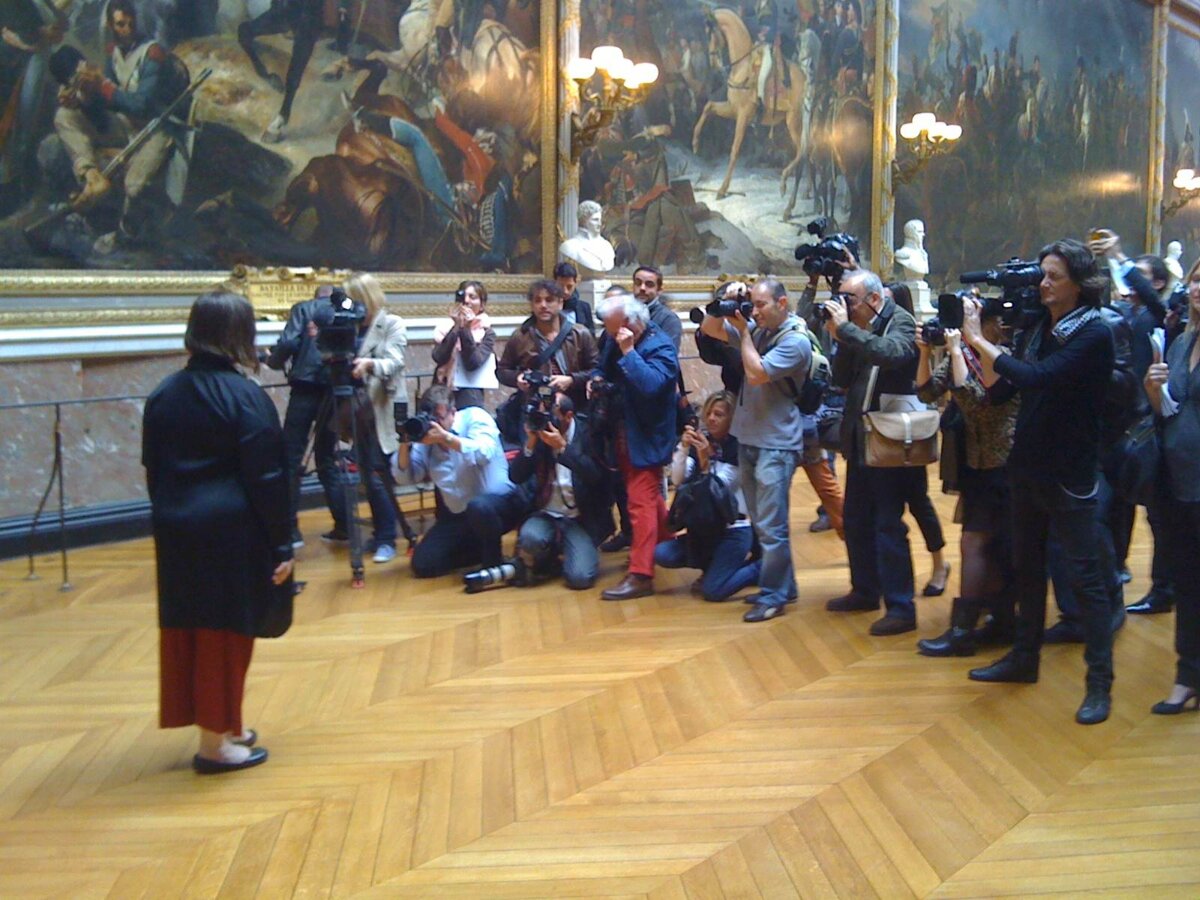
Enlargement : Illustration 1

Perhaps this unexpected harmony has something to do with this exhibition's overt celebration of women, as the “second sex” often played major roles here, albeit behind the scenes.
Vasconcelos is the first woman invited to exhibit at Versailles since the château began – controversially – hosting exhibitions by contemporary artists in 2008. At 41 she is also the youngest artist to date. She is a living counterpoint to the legendary Portuguese melancholia with her colourful, larger-than-life presence, ready laugh and her use of irony as opposed to nostalgia.
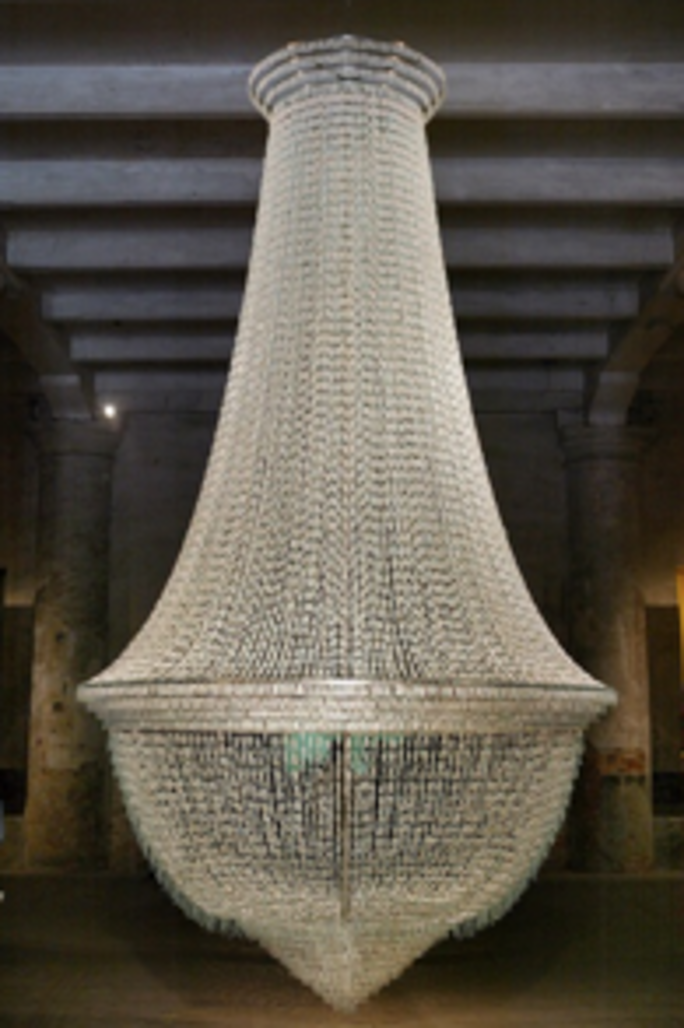
The exhibition, the fruit of 18 months of intensive work, was commissioned when Jean-Jacques Aillagon, former culture minister under President Jacques Chirac, still ruled the roost at Versailles. It was he who instigated summer modern art exhibitions at the château, starting with Jeff Koons in 2008. Xavier Veilhan followed in 2009, Takashi Murakami in 2010 and Bernar Venet in 2011. Each exhibition has been greeted with criticism from people shocked by the juxtaposition of modern art and French tradition.
Then about a year ago, in a move worthy of the Sun King himself, then President Nicolas Sarkozy ousted Aillagon and appointed Catherine Pégard, former editor of Le Point weekly news magazine and one of his minor advisers.
The change almost derailed the exhibition.
Vasconcelos made clear in interviews in the Portuguese press at the time that she did not appreciate the way the new Versailles president had dropped from the exhibition the very work that had brought her worldwide recognition. The piece, A Noiva, (the fiancée), an immense chandelier made with over 20,000 tampons, was first shown at the Venice Biennial in 2005.
Chandelier made of tampons censored
Vasconcelos also referred to the omission at a preview of the exhibition for the press on June 18th – speaking in fluent French, since she was born in 1971 in Paris, where her parents were political refugees. Her father is the photographer Luis Vasconcelos. "In my view, this work should have been part of this exhibition where I made women the key theme," she said. "But this was not the consensus here."
Pégard said she had not given in to pressure and was not being prudish in her decision not to show the work. The exhibition commissioner, Jean-François Chougnet, who is principal director of the Berardo Museum in Lisbon, said A Noiva "could create a row without being completely understood" by visitors, who only look at exhibits for a few minutes.
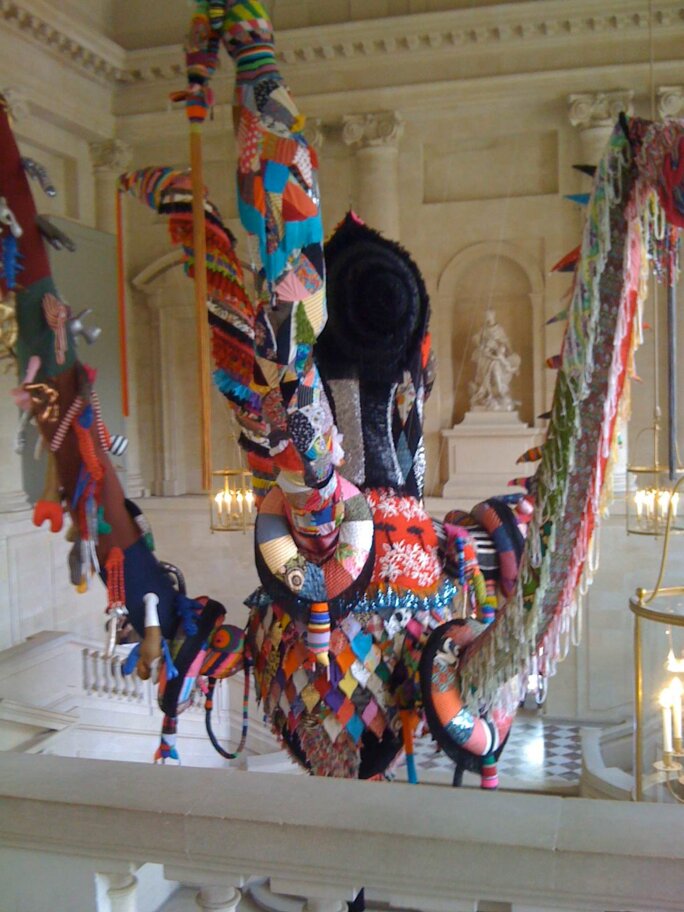
Enlargement : Illustration 3

The exhibition begins with a spectacular sight in the vast Gabriel staircase – the first of Vasconcelos's four Valkyries, this one entitled Mary Poppins.
These tentacular, gigantic rag dolls hang from the ceiling like outsize spiders. The three others are suspended from the glass roofs in the Galerie des Batailles, a place dedicated to glorifying French military history. An appropriate place, says Vasconcelos, since "Valkyries are goddesses of war who went onto the battlefield to come to the aid of heroes."
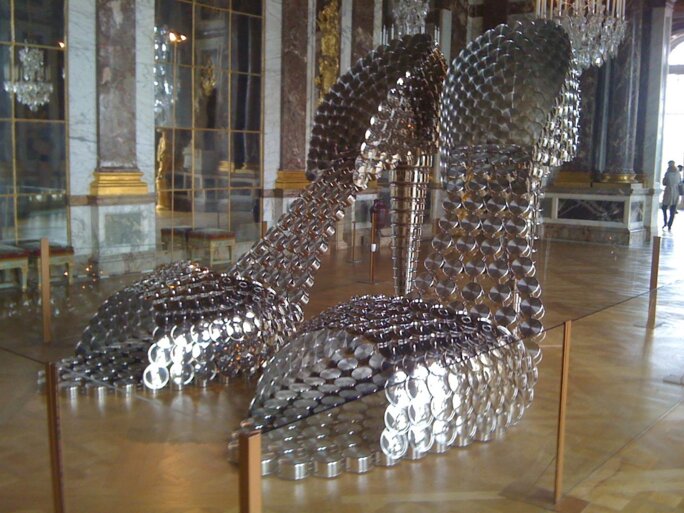
Enlargement : Illustration 4

And then, at the end of the Hall of Mirrors is her renowned work Marilyn, an enormous pair of stiletto-heeled shoes made of hundreds of stainless steel saucepans and their lids. This larger-than-life representation of the ultimate symbol of sex-appeal in our era is a scathing critique of women’s position in the macho subconscious, caught in servitude between the kitchen and the bedroom.
On either side of the Hall of Mirrors, in the War Room and the Peace Room, two versions of her Independent Heart are hung, one red and the other black, made from translucent plastic cutlery.
But Lilicopter, a gilded helicopter-like structure covered in pink ostrich feathers with glass tailpieces, is more off the beaten track and rather cramped in the 1830 Room. This, says Vasconcelos, was the fault of the Versailles trade unions.
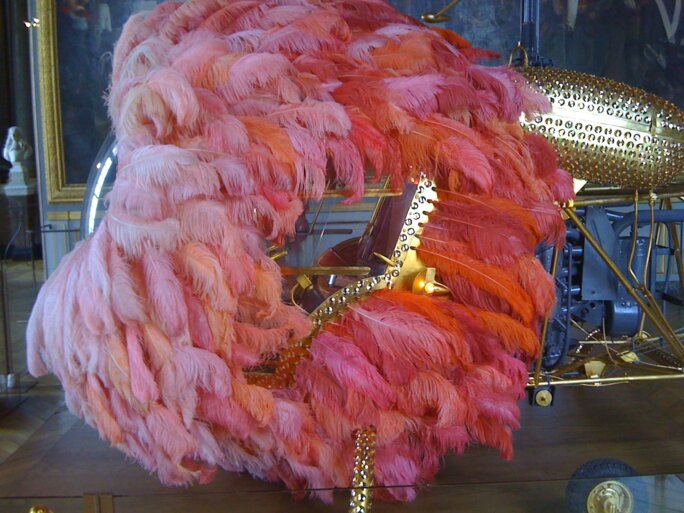
Enlargement : Illustration 5

Remembering the women of Versailles
Vasconcelos is a product of the Portuguese anti-conformist art school Ar.Co, founded in 1973, just before Portugal’s Carnation Revolution which ended Antonio de Oliveira Salazar's dictatorial regime and brought in democratic government. This political change allowed the Vasconcelos family to return to Portugal. The artist, whose work is intensely Portuguese, would later find inspiration in traditional Portuguese artefacts which are currently seeing a renaissance.

Enlargement : Illustration 6
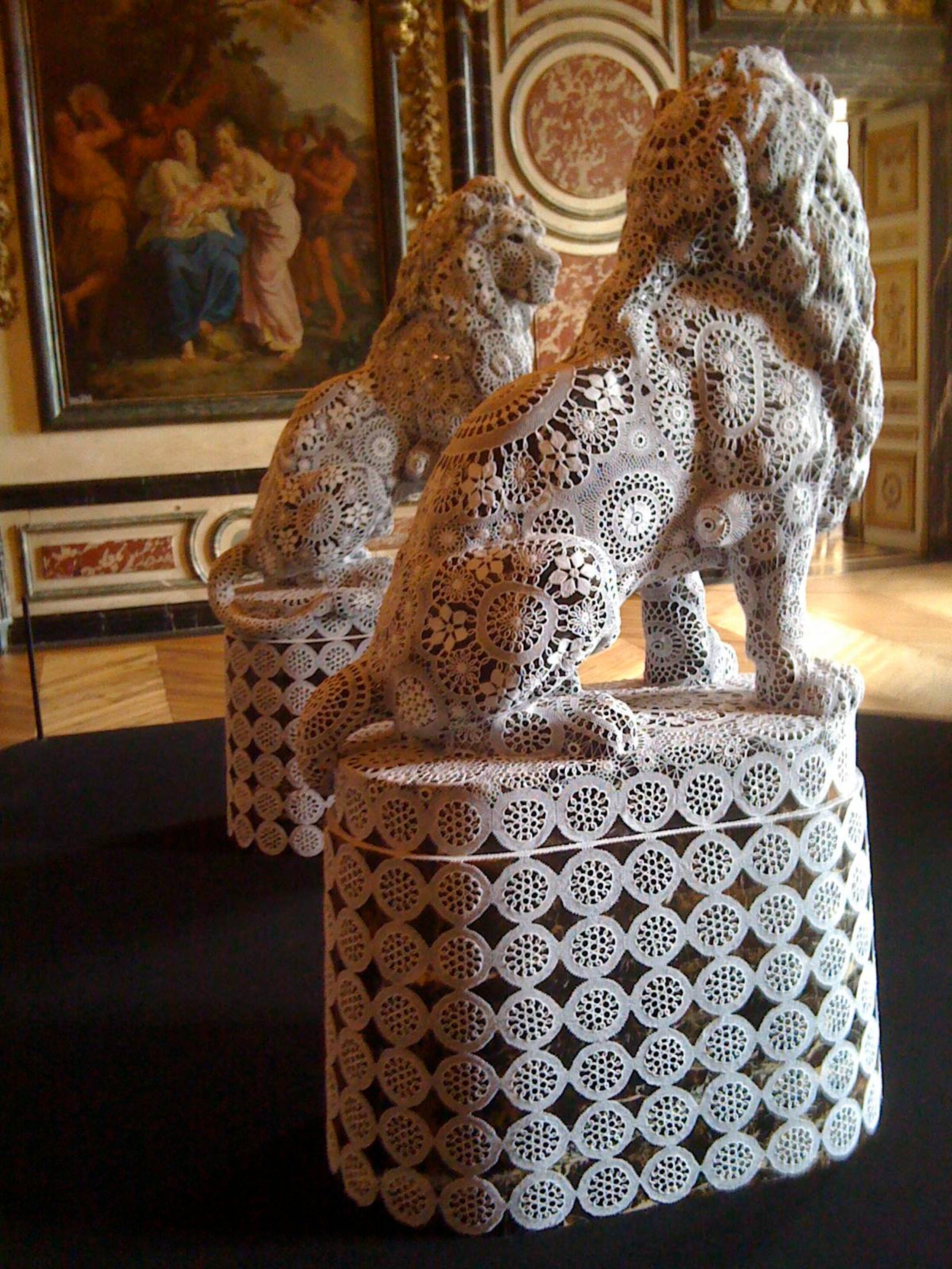
She used fine, crocheted lace from the Azores as a cover for Guards, two statues of lions in marble from Pakistan, and for Le Dauphin et La Dauphine, two outsize lobsters in Rafaël Bordalo Pinheiro faïence.
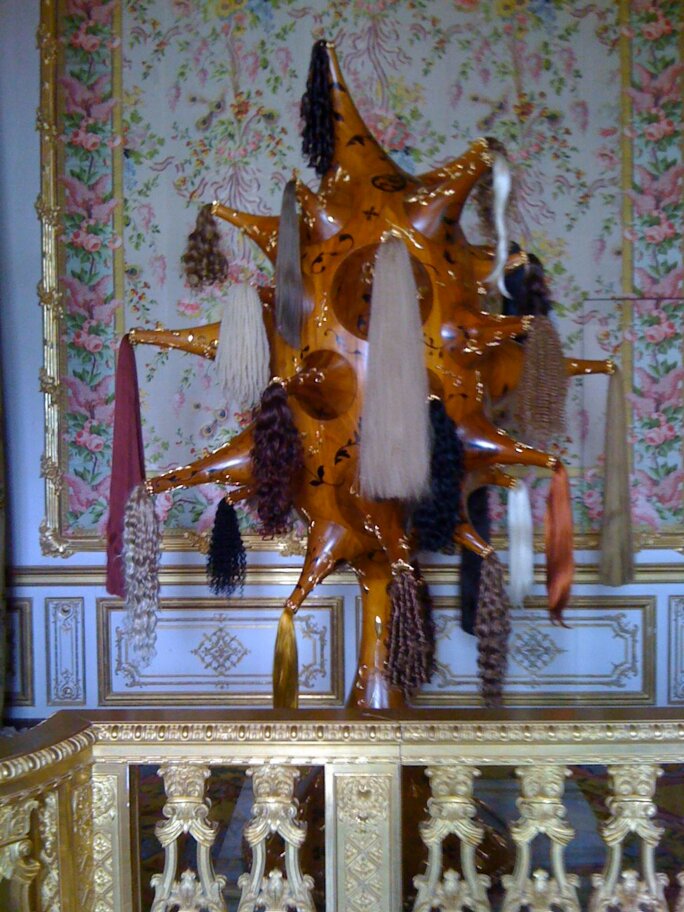
Enlargement : Illustration 7

For Perruque, a work in ebony inlays and gold-plated brass specially conceived for the Queen’s Bedroom at Versailles, Vasconcelos used cabinet makers from the Ricardo Espirito Santo Silva Foundation for decorative arts in Lisbon. She also added in tufts of artificial hair from shops in Lisbon’s Martin Moniz quarter whose customers, it is said, are ladies of the night. That sort of ironic touch is typical of Vasconcelos. "I wanted to evoke the women who slept in this room and gave birth to 19 children in it," she said.
The exhibition extends to the gardens, with a monumental teapot and carafe in wrought iron in the Tea Pavilion and Wine Pavilion. On display outside the château is Blue Champagne, two colossal vertical structures made of blue champagne bottles.
But, true to Versailles' topsy-turvy tradition, he who pays the piper does not call the tune – after all, Louis XIV ruined France with his wars and extravagance. So A Noiva stayed at home despite Portugal’s financial input for the exhibition. Vasconcelos went out of her way at the opening press conference to praise her country's financial commitment at a time of economic hardship. Private French sponsors also contributed to the exhibition, which cost 1.4 million euros according to Pégard.
Thankfully, the artist has a very Portuguese sense of compromise. So millions of visitors to Versailles this summer can admire the art and creativity coming from the far western tip of a Europe whose crisis is as much existential as financial.
--------------------------------
English version: Sue Landau


